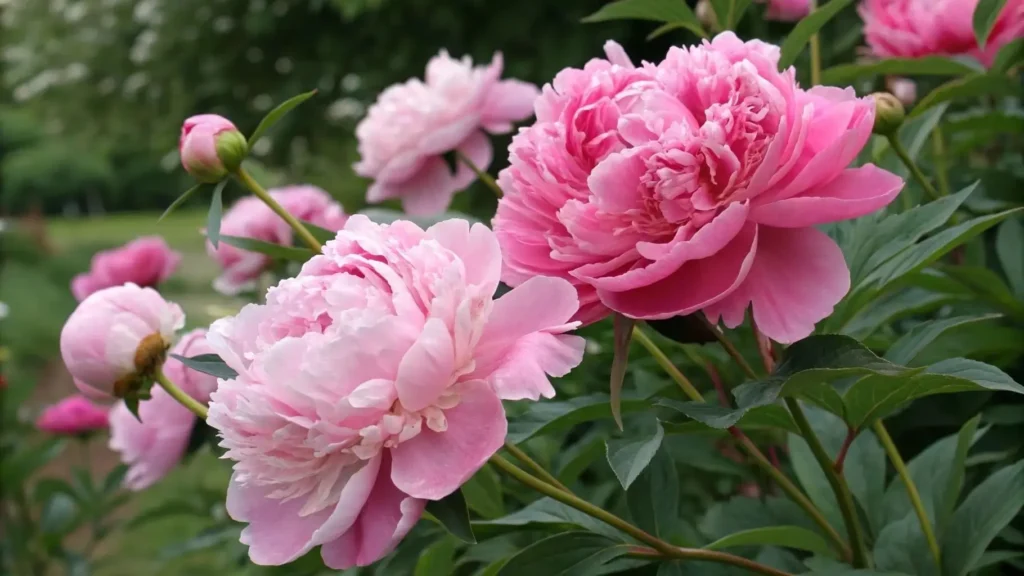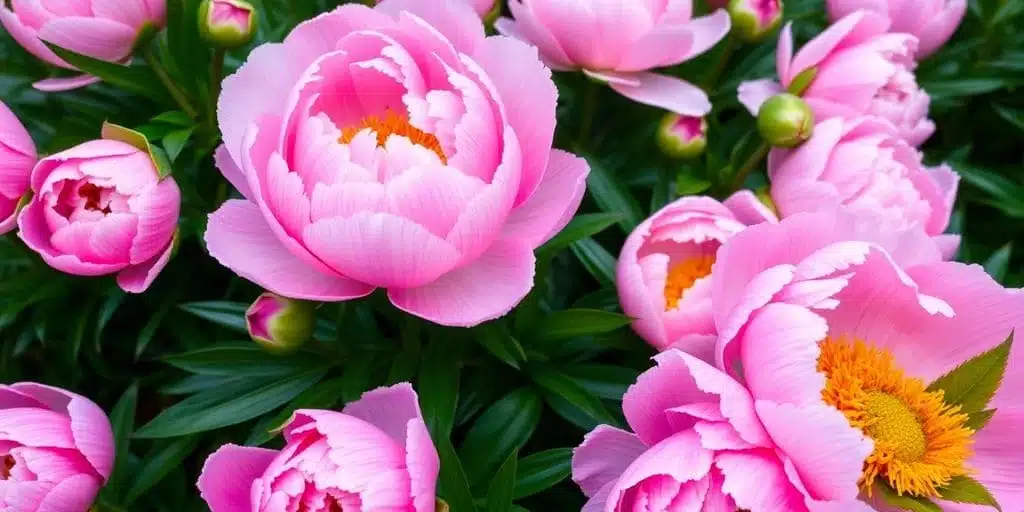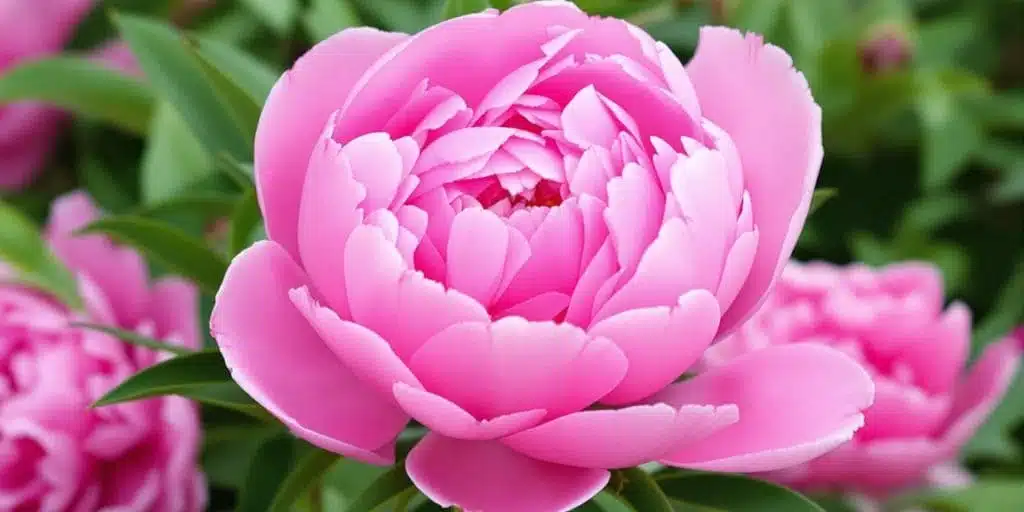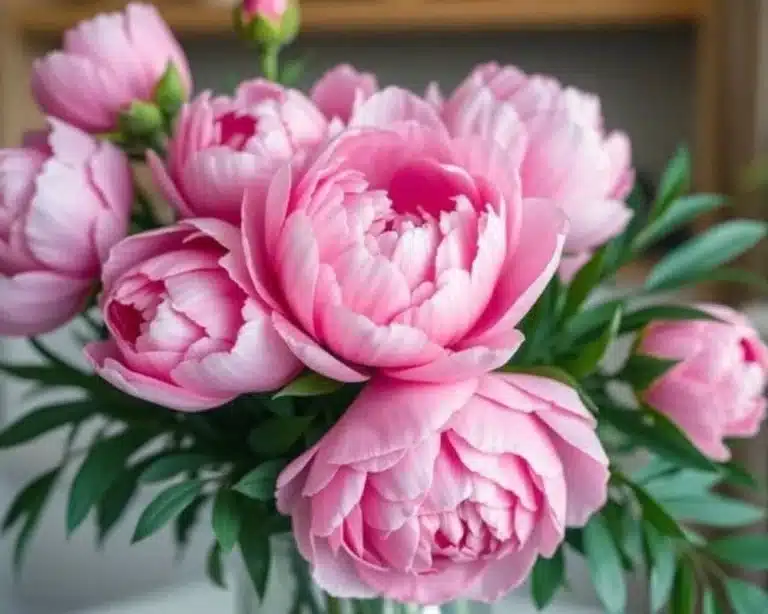A pink peony is like the star of the garden. It’s big, beautiful, and brings so much joy when it blooms. Whether you’re a seasoned gardener or just starting out, a pink peony is a great choice. It comes in different types, each with its own charm and story. Plus, it holds a special place in many cultures. Ready to learn more about this lovely flower? Let’s dive in.
Table of Contents
Different Varieties of the Pink Peony

The pink peony comes in a range of shades and forms, from soft pastels to vibrant magentas. Some popular varieties include ‘Sarah Bernhardt’, known for its large, fragrant bloom, and ‘Monsieur Jules Elie’, which boasts a rich, deep pink color. Each variety offers unique beauty, making it a versatile choice for any garden.
Caring for Your Pink Peony
Watering and Fertilizing Tips
Taking care of pink peonies isn’t too complicated, but it does require some attention to detail. Watering is key—peonies like their soil to be moist, but not soggy. Overwatering can lead to root rot, so it’s important to strike a balance. Aim for about an inch of water per week, either from rainfall or supplemental watering. When it comes to fertilizing, a balanced flower fertilizer applied in early spring can help your peonies thrive.
Pruning and Deadheading Techniques
Pruning your pink peony helps in keeping it healthy and encourages more blooms. After the flower has faded, deadheading—removing spent blooms—can prevent the plant from wasting energy on seed production. In the fall, cut back the stem to just above ground level. This not only tidies up your garden but also reduces the risk of disease.
Pest and Disease Management
Peonies are generally hardy, but they aren’t immune to pests and diseases. Common issues include botrytis blight and powdery mildew. Regularly check your plants for signs of trouble and remove any affected foliage promptly. If pests like aphids or thrips become a problem, a simple spray of insecticidal soap can be effective. Keeping your garden clean and free of debris can also help in preventing infestations.
Maintaining your pink peonies’ health isn’t just about aesthetics. A well-cared-for plant is more resilient and can provide you with beautiful blooms year after year, making all your efforts worthwhile.
Designing with Pink Peony
Incorporating Pink Peony in Floral Arrangements
The pink peony is the epitome of elegance in any floral arrangement. Its lush, full bloom adds a touch of sophistication and charm that few other flowers can match. When planning your flower arrangements, consider the different flower types that complement the peony’s form. Roses, lilacs, and hydrangeas are excellent choices. Here’s a quick list of tips for using pink peonies in arrangements:
- Contrast and Color: Pair them with white or cream flowers for a classic look, or mix with bold colors like purple or deep red for a dramatic effect.
- Vase Selection: Use clear glass vases to showcase their stems, or opt for vintage-style vases for a more romantic feel.
- Arrangement Shape: Keep it loose and natural to highlight the peony’s natural beauty.
Using Pink Peonies in Landscape Design
Incorporating pink peonies into your garden design ideas can transform your outdoor space into a vibrant and elegant retreat. They work beautifully as standalone focal points or as part of a mixed border. Here are some ideas to consider:
- Focal Points: Plant peonies in clusters for a stunning visual impact.
- Borders and Pathways: Use them along garden paths to create a welcoming walkway.
- Companion Planting: Pair with plants like hostas or ferns that thrive in similar conditions.
Pink peonies not only enhance the visual appeal of your garden but also invite a sense of tranquility and peace.
Pairing Pink Peony with Other Flowers
When it comes to pairing the pink peony with other flowers, the options are endless. Its versatility makes it a favorite in flower consultation sessions. Here’s how you can mix and match this elegant flower:
- Seasonal Blooms: Combine with spring bulbs like tulips and daffodils for a seasonal display.
- Texture and Form: Mix with spiky flowers like delphiniums for contrast.
- Color Harmony: Stick to a monochromatic palette for a sophisticated look, or go bold with contrasting colors.
By thoughtfully integrating pink peonies into your floral and garden designs, you can enjoy their timeless beauty and create enchanting spaces that reflect your personal style.
Enjoying the Beauty of Pink Peony

Extending the Blooming Season
The pink peony, with its fragrant flower and lush, ruffled petals, is a favorite flower for many gardeners. To keep this exquisite flower blooming longer, start by selecting varieties with staggered blooming times. This way, you can enjoy fresh flowers from early spring to late summer. Regular deadheading helps too, encouraging more attractive blooms.
Capturing Pink Peonies in Photography
Photographing pink peonies can be a delightful experience. Their huge flowers and fluffy flowers add texture and depth to any photo. Try shooting in the soft light of early morning or late afternoon to capture the vibrant colors of these beautiful flowers. Experiment with angles to highlight their green foliage and single flowers.
Crafting with Pink Peony Petals
Crafting with peony petals is a fun way to extend their beauty beyond the garden. Dry the petals to make potpourri, or use them fresh to decorate cakes. You might even press them for unique, handmade cards. These creative projects allow you to enjoy the peonies’ charm even when they’re not in bloom.
Peonies are not just flowers; they’re an experience. Their presence in your garden can transform an ordinary day into something special, reminding you of dates for flower perfection.
Troubleshooting Common Pink Peony Problems
Identifying and Treating Fungal Diseases
Fungal diseases can be a real headache for anyone growing midseason peonies. One of the most common issues is botrytis blight, which can make your peonies look like they’ve been hit by a sudden frost. To tackle this, first, ensure your plants have good air circulation. Prune away any affected areas and dispose of them properly to avoid spreading the fungus. Fungicides can be effective if applied early, but always follow the instructions carefully.
Dealing with Wilting and Yellowing Leaves
Wilting and yellowing leaves can signal several problems, from overwatering to nutrient deficiencies. Start by checking your watering habits; peonies prefer well-drained soil and can suffer if their roots stay too wet. If water isn’t the issue, consider a soil test to check for nutrient imbalances. Sometimes, a simple adjustment in your fertilizing routine can breathe life back into your plants.
Preventing Pest Infestations
Pests like aphids and thrips can be troublesome for midseason peonies. Here are some steps to keep them at bay:
- Regularly inspect plants for any signs of pests, especially the undersides of leaves.
- Use insecticidal soap or neem oil as a natural remedy to control infestations.
- Encourage beneficial insects like ladybugs, which naturally prey on harmful pests.
Keeping a close eye on your peonies and acting swiftly at the first sign of trouble can save you a lot of headaches down the road. Remember, a healthy peony is less likely to fall victim to pests and diseases.
For more gardening tips, check out Lovers Gardening, where Emily shares insights into the joys of cultivating beautiful plants.
Propagating Pink Peony

Dividing Pink Peony Clumps
Dividing pink peony clumps is a straightforward method to propagate these ancient peonies. This technique not only helps in propagation but also rejuvenates older plants. Here’s how you can do it:
- Timing is Key: The best time to divide peonies is in the fall, after the foliage has died back.
- Digging and Lifting: Carefully dig around the plant and lift the clump from the ground.
- Dividing the Clump: Use a sharp knife to divide the clump into sections, ensuring each has 3-5 eyes (buds).
- Replanting: Plant the divisions immediately, spacing them about 3 feet apart to allow for growth.
Dividing your peonies every 5-10 years can lead to healthier plants and more abundant blooms. It’s a rewarding process that breathes new life into your garden.
Growing Pink Peony from Seeds
Growing pink peonies from seeds requires patience but can be a fun project. While it may take a few years to see the first 1-2 flowers, the wait is often worth it. Here’s a simple guide:
- Seed Collection: Collect seeds from mature peony plants in late summer.
- Stratification: Mimic natural conditions by chilling seeds in the refrigerator for 3 months.
- Sowing: Plant seeds in a well-draining soil mix, about 1 inch deep.
- Germination: Place the pots in a cool, shaded area and keep the soil moist.
Using Cuttings to Propagate Pink Peonies
While not as common as division or seeding, using cuttings can be another way to propagate pink peonies. Follow these steps:
- Select Healthy Stems: Choose stems that are healthy and disease-free.
- Cutting Preparation: Cut a 4-6 inch section, removing the lower leaves.
- Rooting Hormone: Dip the cut end in rooting hormone to encourage growth.
- Planting the Cuttings: Place the cuttings in a pot with moist potting mix and cover with a plastic bag to retain moisture
Wrapping Up Your Peony Journey
Growing pink peonies isn’t just about having a pretty garden; it’s about the joy of watching something beautiful come to life. If you’re ready to deepen your knowledge, don’t miss our pillar article on Poenies Flowers for expert tips and inspiration.
Sure, it takes a bit of patience and care, but the reward is totally worth it. Imagine stepping outside and seeing those gorgeous blooms waving at you in the breeze. It’s like nature’s little gift. Whether you’re a seasoned gardener or just starting out, peonies can bring a touch of elegance to your space. So grab your gardening gloves, get your hands dirty, and enjoy the ride. Happy gardening!
Frequently Asked Questions
When is the best time to plant pink peony?
The ideal time to plant pink peony is in the fall, usually from late September to early November. This allows the roots to establish before winter.
How much sunlight do pink peony need?
Pink peonies thrive in full sunlight, needing at least 6 to 8 hours of direct sunlight each day to grow well and produce blooms.
What kind of soil is best for pink peony?
Pink peonies prefer well-drained soil that is rich in organic matter. Adding compost to the soil can help improve its quality.
How often should I water my pink peony?
Water pink peonies once a week, providing about 1 inch of water each time. Make sure the soil drains well to prevent root rot.
Why are my pink peony leaves turning yellow?
Yellowing leaves can be a sign of overwatering or poor drainage. Make sure your pink peonies are planted in well-drained soil and adjust your watering schedule.
Can I grow pink peonies in pots?
Yes, pink peonies can be grown in pots, but make sure the pot is large enough to accommodate their root system and has good drainage.


3 thoughts on “Pink Peony: Tips for Growing Radiant, Vibrant Blooms”